Fang Wang
Florence Wong
E-ConvNeXt: A Lightweight and Efficient ConvNeXt Variant with Cross-Stage Partial Connections
Aug 28, 2025Abstract:Many high-performance networks were not designed with lightweight application scenarios in mind from the outset, which has greatly restricted their scope of application. This paper takes ConvNeXt as the research object and significantly reduces the parameter scale and network complexity of ConvNeXt by integrating the Cross Stage Partial Connections mechanism and a series of optimized designs. The new network is named E-ConvNeXt, which can maintain high accuracy performance under different complexity configurations. The three core innovations of E-ConvNeXt are : (1) integrating the Cross Stage Partial Network (CSPNet) with ConvNeXt and adjusting the network structure, which reduces the model's network complexity by up to 80%; (2) Optimizing the Stem and Block structures to enhance the model's feature expression capability and operational efficiency; (3) Replacing Layer Scale with channel attention. Experimental validation on ImageNet classification demonstrates E-ConvNeXt's superior accuracy-efficiency balance: E-ConvNeXt-mini reaches 78.3% Top-1 accuracy at 0.9GFLOPs. E-ConvNeXt-small reaches 81.9% Top-1 accuracy at 3.1GFLOPs. Transfer learning tests on object detection tasks further confirm its generalization capability.
Incorporating Legal Logic into Deep Learning: An Intelligent Approach to Probation Prediction
Aug 17, 2025Abstract:Probation is a crucial institution in modern criminal law, embodying the principles of fairness and justice while contributing to the harmonious development of society. Despite its importance, the current Intelligent Judicial Assistant System (IJAS) lacks dedicated methods for probation prediction, and research on the underlying factors influencing probation eligibility remains limited. In addition, probation eligibility requires a comprehensive analysis of both criminal circumstances and remorse. Much of the existing research in IJAS relies primarily on data-driven methodologies, which often overlooks the legal logic underpinning judicial decision-making. To address this gap, we propose a novel approach that integrates legal logic into deep learning models for probation prediction, implemented in three distinct stages. First, we construct a specialized probation dataset that includes fact descriptions and probation legal elements (PLEs). Second, we design a distinct probation prediction model named the Multi-Task Dual-Theory Probation Prediction Model (MT-DT), which is grounded in the legal logic of probation and the \textit{Dual-Track Theory of Punishment}. Finally, our experiments on the probation dataset demonstrate that the MT-DT model outperforms baseline models, and an analysis of the underlying legal logic further validates the effectiveness of the proposed approach.
HGCN(O): A Self-Tuning GCN HyperModel Toolkit for Outcome Prediction in Event-Sequence Data
Jul 30, 2025Abstract:We propose HGCN(O), a self-tuning toolkit using Graph Convolutional Network (GCN) models for event sequence prediction. Featuring four GCN architectures (O-GCN, T-GCN, TP-GCN, TE-GCN) across the GCNConv and GraphConv layers, our toolkit integrates multiple graph representations of event sequences with different choices of node- and graph-level attributes and in temporal dependencies via edge weights, optimising prediction accuracy and stability for balanced and unbalanced datasets. Extensive experiments show that GCNConv models excel on unbalanced data, while all models perform consistently on balanced data. Experiments also confirm the superior performance of HGCN(O) over traditional approaches. Applications include Predictive Business Process Monitoring (PBPM), which predicts future events or states of a business process based on event logs.
CKD-EHR:Clinical Knowledge Distillation for Electronic Health Records
Jun 18, 2025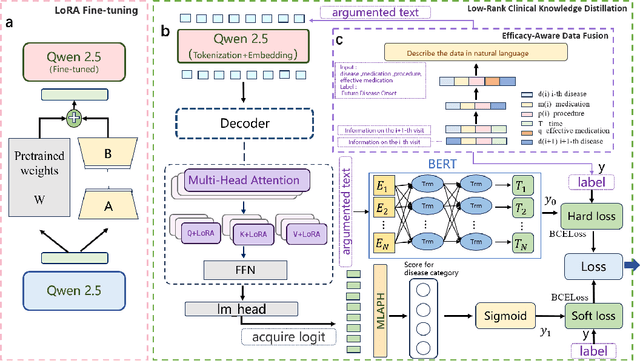
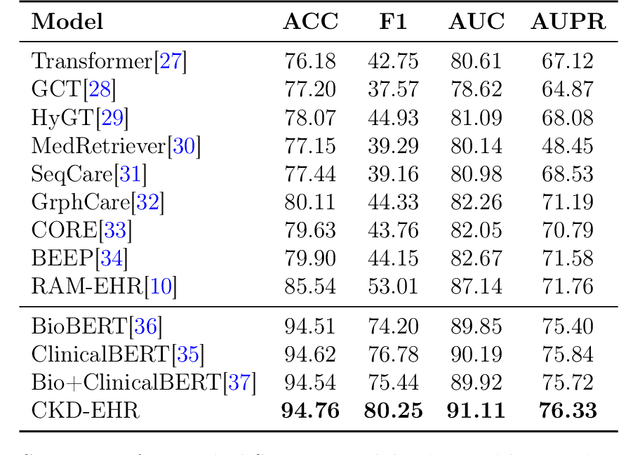

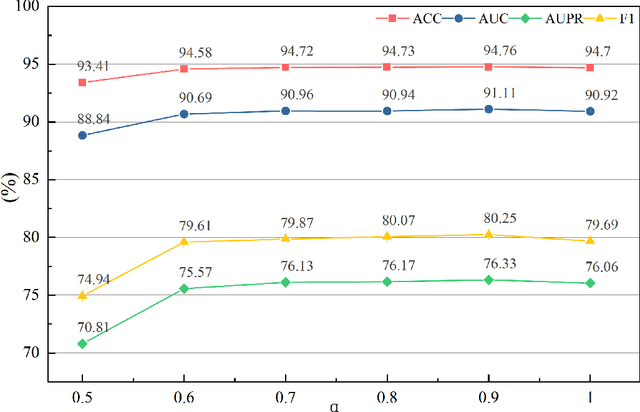
Abstract:Electronic Health Records (EHR)-based disease prediction models have demonstrated significant clinical value in promoting precision medicine and enabling early intervention. However, existing large language models face two major challenges: insufficient representation of medical knowledge and low efficiency in clinical deployment. To address these challenges, this study proposes the CKD-EHR (Clinical Knowledge Distillation for EHR) framework, which achieves efficient and accurate disease risk prediction through knowledge distillation techniques. Specifically, the large language model Qwen2.5-7B is first fine-tuned on medical knowledge-enhanced data to serve as the teacher model.It then generates interpretable soft labels through a multi-granularity attention distillation mechanism. Finally, the distilled knowledge is transferred to a lightweight BERT student model. Experimental results show that on the MIMIC-III dataset, CKD-EHR significantly outperforms the baseline model:diagnostic accuracy is increased by 9%, F1-score is improved by 27%, and a 22.2 times inference speedup is achieved. This innovative solution not only greatly improves resource utilization efficiency but also significantly enhances the accuracy and timeliness of diagnosis, providing a practical technical approach for resource optimization in clinical settings. The code and data for this research are available athttps://github.com/209506702/CKD_EHR.
S2MNet: Speckle-To-Mesh Net for Three-Dimensional Cardiac Morphology Reconstruction via Echocardiogram
May 09, 2025Abstract:Echocardiogram is the most commonly used imaging modality in cardiac assessment duo to its non-invasive nature, real-time capability, and cost-effectiveness. Despite its advantages, most clinical echocardiograms provide only two-dimensional views, limiting the ability to fully assess cardiac anatomy and function in three dimensions. While three-dimensional echocardiography exists, it often suffers from reduced resolution, limited availability, and higher acquisition costs. To overcome these challenges, we propose a deep learning framework S2MNet that reconstructs continuous and high-fidelity 3D heart models by integrating six slices of routinely acquired 2D echocardiogram views. Our method has three advantages. First, our method avoid the difficulties on training data acquasition by simulate six of 2D echocardiogram images from corresponding slices of a given 3D heart mesh. Second, we introduce a deformation field-based method, which avoid spatial discontinuities or structural artifacts in 3D echocardiogram reconstructions. We validate our method using clinically collected echocardiogram and demonstrate that our estimated left ventricular volume, a key clinical indicator of cardiac function, is strongly correlated with the doctor measured GLPS, a clinical measurement that should demonstrate a negative correlation with LVE in medical theory. This association confirms the reliability of our proposed 3D construction method.
CoT-RAG: Integrating Chain of Thought and Retrieval-Augmented Generation to Enhance Reasoning in Large Language Models
Apr 18, 2025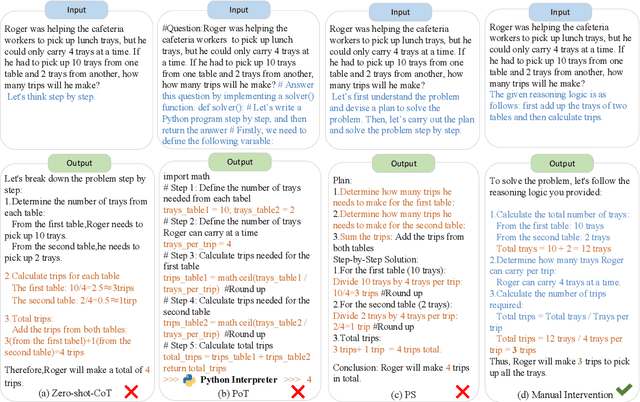

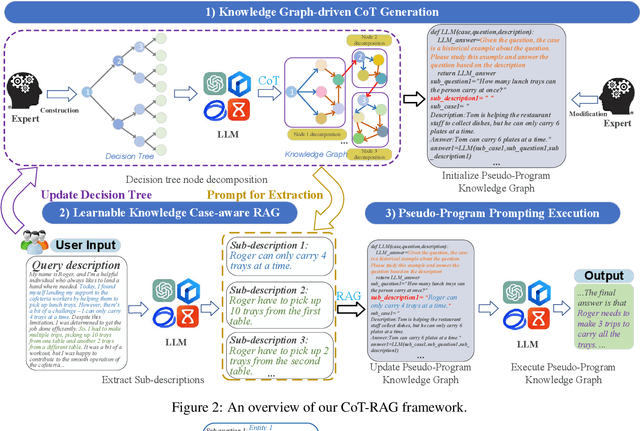

Abstract:While chain-of-thought (CoT) reasoning improves the performance of large language models (LLMs) in complex tasks, it still has two main challenges: the low reliability of relying solely on LLMs to generate reasoning chains and the interference of natural language reasoning chains on the inference logic of LLMs. To address these issues, we propose CoT-RAG, a novel reasoning framework with three key designs: (i) Knowledge Graph-driven CoT Generation, featuring knowledge graphs to modulate reasoning chain generation of LLMs, thereby enhancing reasoning credibility; (ii) Learnable Knowledge Case-aware RAG, which incorporates retrieval-augmented generation (RAG) into knowledge graphs to retrieve relevant sub-cases and sub-descriptions, providing LLMs with learnable information; (iii) Pseudo-Program Prompting Execution, which encourages LLMs to execute reasoning tasks in pseudo-programs with greater logical rigor. We conduct a comprehensive evaluation on nine public datasets, covering three reasoning problems. Compared with the-state-of-the-art methods, CoT-RAG exhibits a significant accuracy improvement, ranging from 4.0% to 23.0%. Furthermore, testing on four domain-specific datasets, CoT-RAG shows remarkable accuracy and efficient execution, highlighting its strong practical applicability and scalability.
LexPro-1.0 Technical Report
Mar 11, 2025Abstract:In this report, we introduce our first-generation reasoning model, LexPro-1.0, a large language model designed for the highly specialized Chinese legal domain, offering comprehensive capabilities to meet diverse realistic needs. Existing legal LLMs face two primary challenges. Firstly, their design and evaluation are predominantly driven by computer science perspectives, leading to insufficient incorporation of legal expertise and logic, which is crucial for high-precision legal applications, such as handling complex prosecutorial tasks. Secondly, these models often underperform due to a lack of comprehensive training data from the legal domain, limiting their ability to effectively address real-world legal scenarios. To address this, we first compile millions of legal documents covering over 20 types of crimes from 31 provinces in China for model training. From the extensive dataset, we further select high-quality for supervised fine-tuning, ensuring enhanced relevance and precision. The model further undergoes large-scale reinforcement learning without additional supervision, emphasizing the enhancement of its reasoning capabilities and explainability. To validate its effectiveness in complex legal applications, we also conduct human evaluations with legal experts. We develop fine-tuned models based on DeepSeek-R1-Distilled versions, available in three dense configurations: 14B, 32B, and 70B.
DeFine: A Decomposed and Fine-Grained Annotated Dataset for Long-form Article Generation
Mar 10, 2025Abstract:Long-form article generation (LFAG) presents challenges such as maintaining logical consistency, comprehensive topic coverage, and narrative coherence across extended articles. Existing datasets often lack both the hierarchical structure and fine-grained annotation needed to effectively decompose tasks, resulting in shallow, disorganized article generation. To address these limitations, we introduce DeFine, a Decomposed and Fine-grained annotated dataset for long-form article generation. DeFine is characterized by its hierarchical decomposition strategy and the integration of domain-specific knowledge with multi-level annotations, ensuring granular control and enhanced depth in article generation. To construct the dataset, a multi-agent collaborative pipeline is proposed, which systematically segments the generation process into four parts: Data Miner, Cite Retreiver, Q&A Annotator and Data Cleaner. To validate the effectiveness of DeFine, we designed and tested three LFAG baselines: the web retrieval, the local retrieval, and the grounded reference. We fine-tuned the Qwen2-7b-Instruct model using the DeFine training dataset. The experimental results showed significant improvements in text quality, specifically in topic coverage, depth of information, and content fidelity. Our dataset publicly available to facilitate future research.
Intelligent Legal Assistant: An Interactive Clarification System for Legal Question Answering
Feb 11, 2025Abstract:The rise of large language models has opened new avenues for users seeking legal advice. However, users often lack professional legal knowledge, which can lead to questions that omit critical information. This deficiency makes it challenging for traditional legal question-answering systems to accurately identify users' actual needs, often resulting in imprecise or generalized advice. In this work, we develop a legal question-answering system called Intelligent Legal Assistant, which interacts with users to precisely capture their needs. When a user poses a question, the system requests that the user select their geographical location to pinpoint the applicable laws. It then generates clarifying questions and options based on the key information missing from the user's initial question. This allows the user to select and provide the necessary details. Once all necessary information is provided, the system produces an in-depth legal analysis encompassing three aspects: overall conclusion, jurisprudential analysis, and resolution suggestions.
Elevating Legal LLM Responses: Harnessing Trainable Logical Structures and Semantic Knowledge with Legal Reasoning
Feb 11, 2025



Abstract:Large Language Models (LLMs) have achieved impressive results across numerous domains, yet they experience notable deficiencies in legal question-answering tasks. LLMs often generate generalized responses that lack the logical specificity required for expert legal advice and are prone to hallucination, providing answers that appear correct but are unreliable. Retrieval-Augmented Generation (RAG) techniques offer partial solutions to address this challenge, but existing approaches typically focus only on semantic similarity, neglecting the logical structure essential to legal reasoning. In this paper, we propose the Logical-Semantic Integration Model (LSIM), a novel supervised framework that bridges semantic and logical coherence. LSIM comprises three components: reinforcement learning predicts a structured fact-rule chain for each question, a trainable Deep Structured Semantic Model (DSSM) retrieves the most relevant candidate questions by integrating semantic and logical features, and in-context learning generates the final answer using the retrieved content. Our experiments on a real-world legal QA dataset-validated through both automated metrics and human evaluation-demonstrate that LSIM significantly enhances accuracy and reliability compared to existing methods.
 Add to Chrome
Add to Chrome Add to Firefox
Add to Firefox Add to Edge
Add to Edge